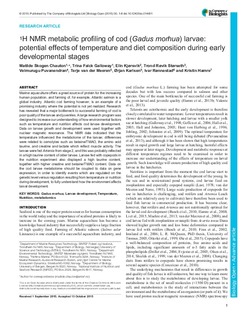1H NMR metabolic profiling of cod (Gadus morhua) larvae: potential effects of temperature and diet composition during early developmental stages
Chauton, Matilde Skogen; Galloway, Trine Falck; Kjørsvik, Elin; Størseth, Trond Røvik; Puvanendran, Velmurugu; van der Meeren, Terje; Karlsen, Ørjan; Rønnestad, Ivar; Hamre, Kristin
Journal article
Permanent lenke
http://hdl.handle.net/11250/2368456Utgivelsesdato
2015Metadata
Vis full innførselSamlinger
- Publikasjoner fra CRIStin - SINTEF AS [5802]
- SINTEF Industri [1566]
Sammendrag
Marine aquaculture offers a great source of protein for the increasing human population, and farming of, for example, Atlantic salmon is a global industry. Atlantic cod farming however, is an example of a promising industry where the potential is not yet realized. Research has revealed that a major bottleneck to successful farming of cod is poor quality of the larvae and juveniles. A large research program was designed to increase our understanding of how environmental factors such as temperature and nutrition affects cod larvae development. Data on larvae growth and development were used together with nuclear magnetic resonance. The NMR data indicated that the temperature influenced the metabolome of the larvae; differenceswere related to osmolytes such as betaine/TMAO, the amino acid taurine, and creatine and lactate which reflect muscle activity. The larvae were fed Artemia from stage 2, and this was probably reflected in a high taurine content of older larvae. Larvae fed with copepods in the nutrition experiment also displayed a high taurine content, together with higher creatine and betaine/TMAO content. Data on the cod larvae metabolome should be coupled to data on gene expression, in order to identify events which are regulated on the genetic level versus regulation resulting from temperature or nutrition during development, to fully understand how the environment affects larval development.
Beskrivelse
-
